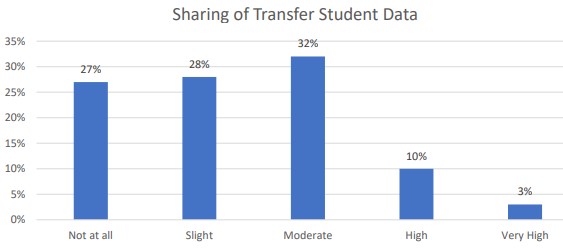Develop, manage, and curate a robust statewide data system and dashboard, and provide the CHE with the authority to request, collect, and analyze data from all participating higher education institutions.
The task force was limited by the availability of data on student transfer within the state. Limited data on statewide transfer (aggregated transfer headcounts by institution for the Fall semester only) are published annually by the CHE. It is possible for the CHE to disaggregate transfer students by race/ethnicity and gender, but this information is not part of standard reporting. Course level and student performance information, such as courses transferred, transfer credits awarded, course grades, and progress towards degree are not reported to the CHE. The CHE does collect credit hours attempted by students at each institution; however, the CHE does not collect data on credits earned, so it is not possible to calculate how many credits a student earned prior to transfer, received through transfer, or earned after transfer.
The National Student Clearinghouse is a data platform, providing key information on student movement at 3,600 postsecondary institutions nationwide. The CHE is currently working to ensure all state institutions participate in the National Student Clearinghouse, so the state will have access to system-wide data. Participation in this platform would provide invaluable data for numerous programs and provide context for recommendations that are state-wide and impact large numbers of postsecondary students in the transfer path.
Information collected through the initial survey found nearly half (47 percent) of reporting South Carolina institutions either occasionally or never obtain data on students transferring into their institutions.
Additionally, institution personnel often do not know or are not informed about 1) transfer student demographics, 2) data that is disaggregated by institutions, to include disaggregated by student demographic characteristics, 3) measures of success such as GPA, degree progress or graduation rates, and retention of transfer students. Without these disaggregated data, identifying impediments to transfer success statewide is impossible.
Additionally, responses from the survey point to an increased need for institutions to share transfer student data with key advisers, faculty, and staff. For example:
When asked if their institution shared transfer student data with the faculty and staff who work directly with transfer students, 55 percent of the respondents said the amount of transfer student data they were given was “slight” to “none at all.”
When asked about how effective transfer student programs were on their campus, in terms of promoting overall transfer student success, many of the respondents (44 percent), indicated “none at all” or “slight.” Without sufficient data on student learning outcomes after participating in a transfer student campus event, the success outcomes simply cannot be gauged, only estimated.
Data from the survey responses also pointed out areas of confidence in the level of success institution faculty and staff expected to see from new transfer students. In other words, exhibiting a strong belief their institution would provide a successful experience for new transfer students translated into higher retention and success rates.
When institutions were asked if they “believe transfer students are more or less successful at your institution than students who began at your institution,” 81 percent of the 475 respondents reported they believed transfer students were equally or more successful than those students who started at the institution.
The survey concluded by asking respondents to examine institutional policy and practice, and statewide policy and practices. More than 60 percent of the respondents indicated their institution strategic plan addressed the success of transfer students to a moderate to very high degree. Yet 56 percent of the respondents indicate data regarding transfer students is not shared with faculty and staff who work with transfer students. This acknowledgement suggests an area for improvement (Figure 1).
Figure 1. Sharing of Transfer Student Data

For these reasons, a robust statewide data system is needed to collect student information, cross reference the transfer student database(s) with student enrollment database(s) and provide access to disaggregated data for statewide tracking. Furthermore, to conduct these activities, the CHE needs to be granted the authority to request, collect, and analyze data from participating institutions. A statewide data system also provides a pathway into deeper collaborations with the SCDE. For example, the recommended data system should be robust enough to include the ability to disaggregate transfer student data by academic history to assess academic needs, such as the need for co-requisites, advising/career counseling, advanced course study offered via the honors program, internships, etc., for a diverse transfer student population. As a result of the available academic history data, institutions could address the identified needs of transfer students by having a required academic checklist of procedures and protocols developed by the registrar’s office in conjunction with the Division of Academic Affairs to be completed at the time of enrollment and maintained for continuous advisement.
Furthermore, the utilization of existing state data resources, such as the RFA, could further enhance a data system by including student information that could inform support services. For example, the data system could be used to assess needs such as housing, financial aid, childcare, etc. for a diverse transfer student population. Implementation of a data system would allow the publishing of institutional information to a dashboard that would allow transfer students to make informed decisions about degree programs.
Higher Education Institution Action: Upon further guidance from the CHE, participating institutions should commit to submitting the needed data variables consistently and accurately for the data system and dashboard.
Legislative Action: Statutory or regulatory action may be required to grant the CHE authority to request, collect, and analyze additional data. Collaborations with other state agencies (e.g., SCDE, RFA) may be required with legislative action.
Implementation Timeline: Implementation is immediately after proper authority is granted to the CHE and publishing of variables are presented to participating institutions. Sufficient time should be given for institutions to update data systems to allow for streamlined submission.
